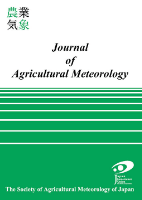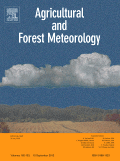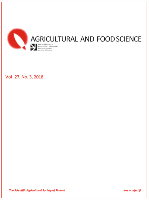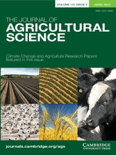
JOURNAL OF AGRICULTURAL METEOROLOGY
Scope & Guideline
Advancing Research at the Intersection of Climate and Crops.
Introduction
Aims and Scopes
- Impact of Climate on Agriculture:
Research focusing on how various climatic factors, such as temperature and precipitation, affect agricultural productivity and crop yields. - Mitigation of Agricultural Emissions:
Studies aimed at understanding and reducing greenhouse gas emissions from agricultural practices, including methane and carbon dioxide. - Crop Physiology and Adaptation:
Investigations into how crops respond physiologically to environmental changes, including light, temperature, and atmospheric CO2 levels. - Remote Sensing and Monitoring Techniques:
Utilization of advanced technologies such as drones and satellite imagery for monitoring crop health, growth, and environmental impacts. - Soil and Water Management:
Research on soil health, moisture management, and the effects of various agricultural practices on soil and water resources. - Ecosystem Services and Biodiversity:
Exploration of how agricultural practices influence ecosystem services and biodiversity within agricultural landscapes.
Trending and Emerging
- Climate Change Adaptation Strategies:
Increasing focus on developing and assessing strategies for agricultural adaptation to climate change, including crop diversification and resilient farming practices. - Utilization of Machine Learning Techniques:
Growing interest in applying machine learning and artificial intelligence to analyze agricultural data and improve predictive modeling for crop yields and environmental impacts. - Sustainable Agricultural Practices:
A rising trend towards research on sustainable practices, including organic farming and agroecology, emphasizing environmental stewardship and resource conservation. - Integration of Remote Sensing Data:
Enhanced incorporation of remote sensing technologies for monitoring and evaluating agricultural systems, leading to more precise and timely agricultural management. - Research on Crop Resilience to Extreme Weather:
Increased studies focusing on how crops can withstand extreme weather events, such as droughts and floods, highlighting the need for resilient agricultural systems.
Declining or Waning
- Historical Climate Assessments:
There has been a noticeable decrease in publications focusing solely on historical climate assessments in agriculture, as more emphasis is placed on real-time data and predictive modeling. - Traditional Pest Management Practices:
Research on conventional pest management strategies appears to be waning, possibly due to a shift toward integrated pest management and sustainable farming practices. - Static Modeling Approaches:
The use of static models to predict agricultural outcomes is declining as dynamic, real-time modeling approaches gain traction, reflecting the need for more adaptable agricultural strategies.
Similar Journals

Agronomy-Basel
Advancing Agricultural Practices Through Open Access ResearchAgronomy-Basel is a leading international journal dedicated to advancing the field of agronomy and crop science, published by the respected MDPI. Since its inception in 2011, this open-access journal has provided a vital platform for the dissemination of high-quality research, featuring innovative studies and reviews that contribute to the understanding of agricultural practices and crop management. With an impressive impact factor and ranked in the Q1 quartile of its category for 2023, Agronomy-Basel has established itself as a premier resource in the realm of Agricultural and Biological Sciences, achieving a commendable rank of #62 out of 406 in its field, placing it in the 84th percentile. The journal targets researchers, professionals, and students who are dedicated to enhancing agricultural sustainability and productivity. Located in Basel, Switzerland, the journal's commitment to open access empowers global accessibility to flourishing agricultural advancements, thus fostering collaboration and innovation across the globe.

Scientific Papers-Series A-Agronomy
Unlocking the Potential of Agricultural ScienceScientific Papers-Series A-Agronomy is a premier academic journal dedicated to the field of agronomy, published by the University of Agronomic Sciences and Veterinary Medicine Bucharest. With an emphasis on innovative research and practical applications, this journal serves as a vital platform for disseminating new findings in agricultural science, sustainable practices, and crop management strategies. Though the journal currently operates under traditional access options, it remains pivotal in supporting the academic community in Romania and beyond. The ISSN (2285-5785) and E-ISSN (2285-5807) ensure that the work published is easily accessible to researchers and practitioners alike, fostering the exchange of knowledge and advancements within the agricultural sector. By continually addressing contemporary issues in agronomy, Scientific Papers-Series A-Agronomy strives to promote sustainable agricultural practices and enhance food security, making it an essential resource for professionals, students, and researchers keen on advancing their understanding and expertise in this critical field.

AGRICULTURAL AND FOREST METEOROLOGY
Transforming insights into action for sustainable ecosystems.AGRICULTURAL AND FOREST METEOROLOGY, published by Elsevier, is a premier journal dedicated to the intersection of meteorology, agriculture, and forestry, with a substantial impact on the understanding of climate interactions and their implications on natural resources and food security. Featuring an ISSN of 0168-1923 and an E-ISSN of 1873-2240, this journal has maintained an impressive track record since its establishment in 1984 and is set to continue through 2024. Currently categorized in the Q1 quartile across multiple fields—including Agronomy and Crop Science, Atmospheric Science, Forestry, and Global and Planetary Change—AGRICULTURAL AND FOREST METEOROLOGY is recognized as a leading source in its disciplines, ranked in the 94th percentile for both Agronomy and Atmospheric Science. Researchers and professionals in the field can expect to find high-quality, peer-reviewed articles that contribute significantly to the advancement of knowledge and practice. This journal serves as an essential platform for disseminating critical findings that inform science-based strategies for managing agricultural and forest ecosystems in response to a changing climate.

AGRICULTURAL AND FOOD SCIENCE
Championing sustainable solutions in agriculture and food sciences.AGRICULTURAL AND FOOD SCIENCE is a prestigious journal published by the SCIENTIFIC AGRICULTURAL SOCIETY OF FINLAND, dedicated to advancing knowledge in the fields of agricultural and food sciences. With an ISSN of 1459-6067 and E-ISSN of 1795-1895, this open-access journal has been providing valuable insights and research findings since its inception in 2002. As of 2023, it holds a Q3 ranking in Food Science and is positioned at the 46th percentile within its Scopus category, ranking 210 out of 389 journals in Agricultural and Biological Sciences – Food Science. The journal features contributions from a global network of researchers, covering various topics including sustainable agricultural practices, food safety, and innovative food technologies. Based in Finland, the journal serves as an essential platform for scholars, professionals, and students who are committed to enhancing food security and agricultural productivity through rigorous scientific research. The convergence of interdisciplinary studies from 2004 to 2024 marks a critical evolution in the scope of agricultural and food research, making this journal a vital resource for anyone involved in these dynamic fields.

Journal of the ASABE
Unlocking Knowledge for Global Agricultural ProgressJournal of the ASABE, published by the American Society of Agricultural and Biological Engineers, serves as a pivotal platform for disseminating cutting-edge research in various disciplines, including Agronomy, Crop Science, Biomedical Engineering, Food Science, Forestry, and Soil Science. With an impact factor that reflects its significance and reach, the journal ranks in the Q2 and Q3 quartiles across numerous categories in 2023, showcasing its commitment to advancing knowledge in agricultural and biological engineering. Authored by leading experts, the journal offers accessible articles on innovative methodologies, technologies, and sustainable practices essential to the global agricultural and environmental landscape. Open access options ensure that research findings are readily available to a broad audience, promoting collaboration and knowledge sharing among researchers, professionals, and students alike. With a strategic focus on research convergence into 2024, Journal of the ASABE is poised to shape the future of engineering solutions in agriculture and beyond.

Romanian Agricultural Research
Fostering Dialogues for Sustainable Agricultural DevelopmentRomanian Agricultural Research is a prominent academic journal dedicated to advancing the field of agricultural science with a specific focus on agronomy and crop management. Published by the NATL AGRICULTURAL RESEARCH & DEVELOPMENT INST in Romania, this journal has established itself as an important resource within its discipline, evidenced by its Q3 ranking in the Agronomy and Crop Science category for 2023. With its ongoing publication since 2008, the journal provides a platform for researchers and professionals to disseminate their findings and share innovative practices that address the challenges faced in agricultural development. Although it operates under a non-open access model, Romanian Agricultural Research commits to rigorous peer-review processes, ensuring the high-quality content that enhances the academic community’s knowledge base. The journal's objective is to foster dialogues surrounding sustainable agriculture, improve crop yield, and contribute to the enhancement of agricultural practices globally. Researchers, professionals, and students will find this journal to be an invaluable repository of knowledge and a catalyst for future agricultural innovations.

JOURNAL OF AGRICULTURAL SCIENCE
Advancing Agricultural Innovation Through ResearchJOURNAL OF AGRICULTURAL SCIENCE, published by Cambridge University Press, stands as a pivotal resource in the field of agricultural research. With a rich history dating back to 1905, this esteemed journal has consistently delivered cutting-edge scholarly articles that address pressing issues in agronomy, crop science, animal science, and genetics. Currently holding a Q2 ranking in Agronomy and Crop Science and Animal Science and Zoology, and a Q3 in Genetics, it reflects a robust impact within the academic community, contributing to innovative practices and technologies in agriculture. Indexed in Scopus, its authors benefit from broad visibility, supported by a strong readership among researchers, professionals, and students alike. While the journal does not currently offer open access, its rigorous peer-review process ensures that published works meet the highest scholarly standards, fostering a rich environment for knowledge exchange and advancement in agricultural science.

Revista Brasileira de Ciencias Agrarias-Agraria
Fostering innovation in agriculture through open access.Revista Brasileira de Ciencias Agrarias-Agraria is an esteemed academic journal published by the Universidade Federal Rural de Pernambuco, dedicated to advancing the field of agricultural and biological sciences. With a focus on disseminating high-quality research, this journal plays a pivotal role in fostering knowledge exchange within the agricultural community, particularly in Brazil and beyond. As a Q3 ranked publication in the Agricultural and Biological Sciences category, Revista Brasileira de Ciencias Agrarias-Agraria contributes to the growing body of literature by featuring insightful articles from both emerging and established researchers in the field. The journal has been consistently published since 2011 and is committed to open access principles, ensuring that research findings are accessible to a wide audience. Researchers, professionals, and students will find this journal an invaluable resource for deepening their understanding of current trends and innovations in agriculture.

APPLIED ENGINEERING IN AGRICULTURE
Transforming Agriculture Through Innovative Engineering Solutions.APPLIED ENGINEERING IN AGRICULTURE is a peer-reviewed journal published by the American Society of Agricultural and Biological Engineers, dedicated to advancing the field of agricultural engineering through the dissemination of high-quality research. With an ISSN of 0883-8542 and an e-ISSN of 1943-7838, this journal has been a key resource since its inception in 1985, serving as a vital platform for scholars and practitioners to share innovative ideas and practical solutions that enhance productivity and sustainability in agricultural practices. The journal is ranked in the Q3 category for Engineering (miscellaneous) as of 2023, and is positioned within the 43rd percentile of the general engineering rankings in Scopus. While not currently an open-access journal, APPLIED ENGINEERING IN AGRICULTURE remains crucial for researchers and professionals looking to explore diverse engineering solutions that address the complexities of modern agriculture, making it an invaluable resource for anyone committed to improving agricultural systems through engineering advancements.

Agrosystems Geosciences & Environment
Empowering knowledge generation in agricultural sciences.Agrosystems Geosciences & Environment, published by WILEY, is a premier open access journal dedicated to advancing the interdisciplinary field of agricultural and environmental sciences. With an E-ISSN of 2639-6696, the journal has gained recognition since its inception in 2018, currently holding a Q2 ranking in Agricultural and Biological Sciences, Plant Science, and Soil Science. Operating from the United Kingdom, Agrosystems Geosciences & Environment contributes significantly to knowledge generation and dissemination, offering vital insights into sustainable practices, soil management, and crop optimization. Researchers and professionals will find the open access model particularly advantageous, promoting greater visibility and engagement within the scientific community. By bridging the gap between geosciences and agrosystem management, this journal is vital for those committed to addressing today's critical environmental challenges.